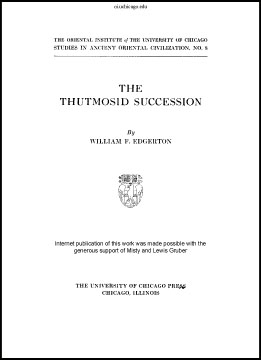SAOC 8. The Thutmosid Succession William F. Edgerton

The exact chronological relation between the reign of the "female king" Hatshepsut and her immediate male relatives, the first three Thutmoses, has always been a subject of disagreement among Egyptologists.
In 1896, Sethe undertook to prove that the order of succession was (1) Thutmose I; (2) Thutmose III; (3) Hatshepsut and Thutmose III jointly; (4) Thutmose III again alone; (5) Thutmose II (jointly with Thutmose I until Thutmose I died, afterward alone); (6) Hatshepsut and Thutmose III until Hatshepsut died, after which (7) Thutmose III ruled alone. The evidence on which Sethe relied was extremely complicated, and those scholars who were qualified to weigh it independently differed widely in their attitudes toward it.
The year 1928 marked an important change in the history of the problem; for in that year Sethe's theory was positively repudiated in toto by two scholars working independently of each other. Sethe has now reviewed the whole subject in a very closely reasoned volume, Das Hatschepsut-Problem noch einmal untersucht, in which his theory is greatly simplified and, to that extent, rendered more plausible. Anyone who wishes to form an independent opinion must have both this book and the Thronwirren at his elbow; no other published presentation of the evidence begins to equal these in thoroughness, and none can surpass them in dispassionate objectivity
In this volume, Edgerton reexamines the whole matter and offers his results for the criticism of scholars. Edgerton based his study primarily on the ancient evidence as collected by Sethe in the Thronwirren and revised by him in Das Hatschepsut-Problem, checked by the original monuments themselves.
- Studies in Ancient Oriental Civilization 8
- Chicago: University of Chicago Press, 1933
- Pp. ix + 43; 5 figures
- Out of Print

